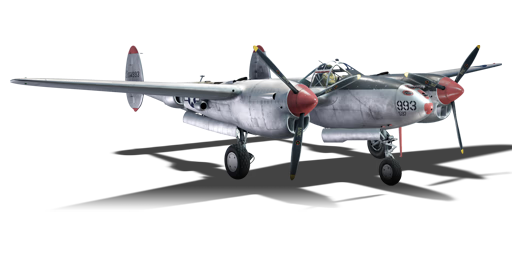


Bong's P-38J-15 is a premium gift American twin-engine fighter. It was available in Update 1.57 "Battle March" as a reward vehicle for the 2016 "Chronicles of World War II". The plane is painted after the camouflage scheme of American pilot Richard Bong of the US Army Air Forces, who is the highest-scoring American pilot ace with 40 kill credited in a P-38.
The P-38J is a sleekly designed, twin-engine monoplane by Lockheed. This plane has a top speed of 431 mph (694 km/h) with an airspeed warning at 460 mph (740 km/h). The weaponry installed is 1 x 20 mm AN/M2 cannon with 4 x 12.7 mm Browning machine guns. Further expanding the role, with upgrades, it can be equipped with either rockets or bombs to further allow it to conquer and dominate the battlefield, whether that be air or ground.
flaps
flaps
flaps
brake
| Belt | Belt filling | Armor penetration (mm) at a distance: | |||||
|---|---|---|---|---|---|---|---|
| 10 m | 100 m | 500 m | 1000 m | 1500 m | 2000 m | ||
| HEF-I/AP-T | 39 | 36 | 25 | 16 | 10 | 6 | |
| AP-T/AP-T/HEF-I/HEF-I | 39 | 36 | 25 | 16 | 10 | 6 | |
| HEF-I/HEF-I/HEF-I/AP-T | 39 | 36 | 25 | 16 | 10 | 6 | |
| AP-T/AP-T/AP-T/HEF-I | 39 | 36 | 25 | 16 | 10 | 6 | |
| HEF-I | 5 | 4 | 3 | 2 | 2 | 2 | |
| Belt | Belt filling | Armor penetration (mm) at a distance: | |||||
|---|---|---|---|---|---|---|---|
| 10 m | 100 m | 500 m | 1000 m | 1500 m | 2000 m | ||
| API-T/AP/AP/I | 30 | 27 | 20 | 13 | 9 | 6 | |
| AP-I/AP-I/API-T/I/I | 28 | 26 | 18 | 11 | 7 | 4 | |
| API-T/I/AP/AP/AP-I/AP-I | 30 | 27 | 20 | 13 | 9 | 6 | |
| API-T | 28 | 26 | 18 | 11 | 7 | 4 | |
| AP-I/I/AP-I/I | 28 | 26 | 18 | 11 | 7 | 4 | |







 2 x (95 / 235 / 495) %
2 x (95 / 235 / 495) % 
 2 x 172 %
2 x 172 % 

Flight performance | |
|---|---|
Survivability |
|---|
Weaponry | |
|---|---|